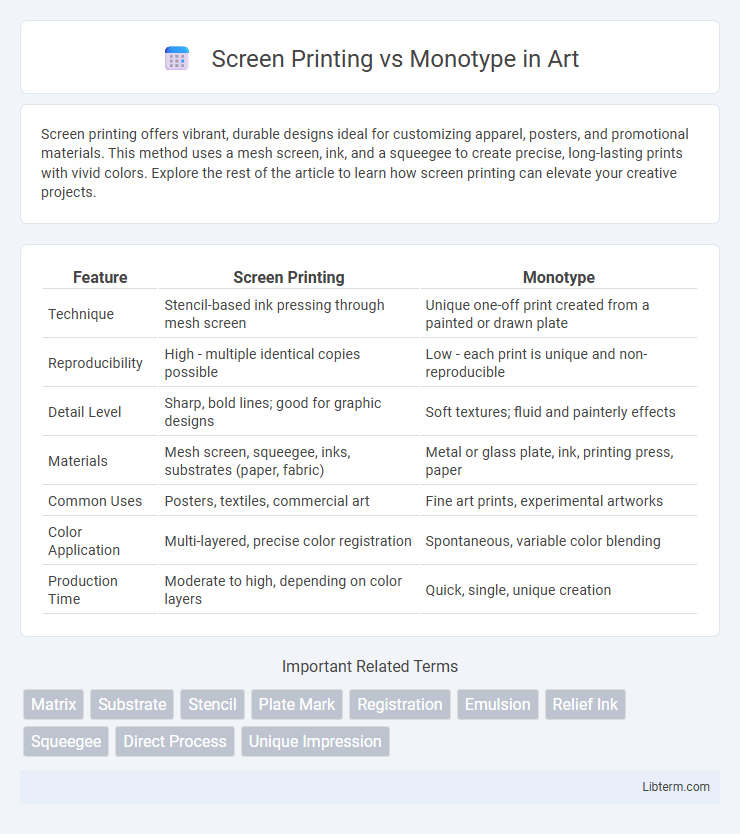Screen printing offers vibrant, durable designs ideal for customizing apparel, posters, and promotional materials. This method uses a mesh screen, ink, and a squeegee to create precise, long-lasting prints with vivid colors. Explore the rest of the article to learn how screen printing can elevate your creative projects.
Table of Comparison
| Feature | Screen Printing | Monotype |
|---|---|---|
| Technique | Stencil-based ink pressing through mesh screen | Unique one-off print created from a painted or drawn plate |
| Reproducibility | High - multiple identical copies possible | Low - each print is unique and non-reproducible |
| Detail Level | Sharp, bold lines; good for graphic designs | Soft textures; fluid and painterly effects |
| Materials | Mesh screen, squeegee, inks, substrates (paper, fabric) | Metal or glass plate, ink, printing press, paper |
| Common Uses | Posters, textiles, commercial art | Fine art prints, experimental artworks |
| Color Application | Multi-layered, precise color registration | Spontaneous, variable color blending |
| Production Time | Moderate to high, depending on color layers | Quick, single, unique creation |
Introduction to Screen Printing and Monotype
Screen printing is a versatile printing technique that uses a mesh screen to transfer ink onto a substrate, creating layers of vibrant color with precision and durability. Monotype, on the other hand, is a unique printmaking process where a single impression is created by applying ink or paint onto a smooth surface, then pressing paper onto it to capture a one-of-a-kind image. Both methods offer distinct artistic qualities: screen printing excels in producing consistent, bold designs, while monotype emphasizes spontaneity and texture.
Historical Background and Origins
Screen printing originated in ancient China during the Song Dynasty (960-1279 AD) and was later refined in Japan, evolving into a popular printing technique used for textiles and posters. Monotype printing was developed in the early 17th century by Italian artist Giovanni Benedetto Castiglione, known for producing unique prints by drawing or painting on a smooth metal or glass surface before pressing it onto paper. Both methods have distinct historical roots that influenced modern art and commercial printing industries.
Materials and Tools Required
Screen printing requires a mesh screen, squeegee, stencil, and specialized inks designed for fabric or paper, ensuring vibrant and durable prints. Monotype relies on a smooth metal or plexiglass plate, oil-based or water-based inks, and a printing press or hand tools to transfer unique, one-of-a-kind impressions. The choice of materials directly impacts the texture and detail, with screen printing offering bold, repeatable designs and monotype producing singular, painterly effects.
Step-by-Step Process Overview
Screen printing involves creating a stencil on a mesh screen, then pushing ink through the mesh onto the substrate layer by layer, allowing vibrant color application and precise detail. Monotype printing starts with painting or inking a smooth plate, then pressing paper onto the plate to transfer a unique, one-of-a-kind print characterized by rich textures and spontaneous effects. Both methods require careful preparation and timing, but screen printing excels in producing consistent multiples, while monotype prioritizes singular artistic expression.
Key Differences in Technique
Screen printing employs a stencil and mesh screen to transfer ink onto a substrate, allowing for multiple, consistent reproductions with vibrant color layering. Monotype, in contrast, involves painting or drawing directly onto a smooth surface like glass or metal, producing a single unique print through pressing paper onto the inked image. The key difference lies in screen printing's repetitive, template-based process versus monotype's one-of-a-kind, freeform image creation.
Artistic Effects and Visual Outcomes
Screen printing offers vibrant, bold colors with sharp edges and smooth overlays, ideal for producing consistent and graphic visual effects. Monotype creates unique, one-of-a-kind prints characterized by rich textures, spontaneous brushstrokes, and subtle color variations that enhance the artistic expressiveness. The distinct visual outcomes of screen printing emphasize precision and reproducibility, while monotype captures fluidity and organic imperfection in each print.
Advantages of Screen Printing
Screen printing offers vibrant color density and durability, making it ideal for long-lasting designs on various materials like textiles, plastics, and metals. Its ability to produce consistent, high-volume outputs quickly surpasses monotype methods, which are generally slower and less suited for mass production. The versatility of screen printing ensures sharp and detailed images, perfect for commercial and promotional applications.
Advantages of Monotype
Monotype offers unique advantages such as producing one-of-a-kind prints with rich texture and depth, unlike screen printing's repetitive nature. Its ability to combine spontaneous brushstrokes with precise control enables artists to achieve expressive and detailed imagery. Monotype printing also requires less setup time and materials, making it more cost-effective and accessible for limited editions and experimental designs.
Common Applications and Uses
Screen printing excels in producing vibrant, durable designs on textiles, posters, and promotional materials, making it a preferred choice for apparel, signage, and commercial artwork. Monotype is primarily used in fine art and printmaking due to its unique, one-of-a-kind prints that emphasize painterly textures and spontaneous creativity. While screen printing is favored for mass production, monotype suits limited editions and artistic experimentation.
Choosing the Right Method for Your Artwork
Screen printing offers vibrant color layers and durability, ideal for bold, graphic designs and large editions, while monotype provides unique, one-of-a-kind prints with subtle textures and fluid details, perfect for expressive and experimental artwork. Consider the scale and purpose of your project: screen printing suits mass production and precise color control, whereas monotype excels in creating singular artistic impressions with organic variations. Evaluate your artistic goals, desired aesthetic effects, and production volume to determine the best method for your artwork.
Screen Printing Infographic

 libterm.com
libterm.com